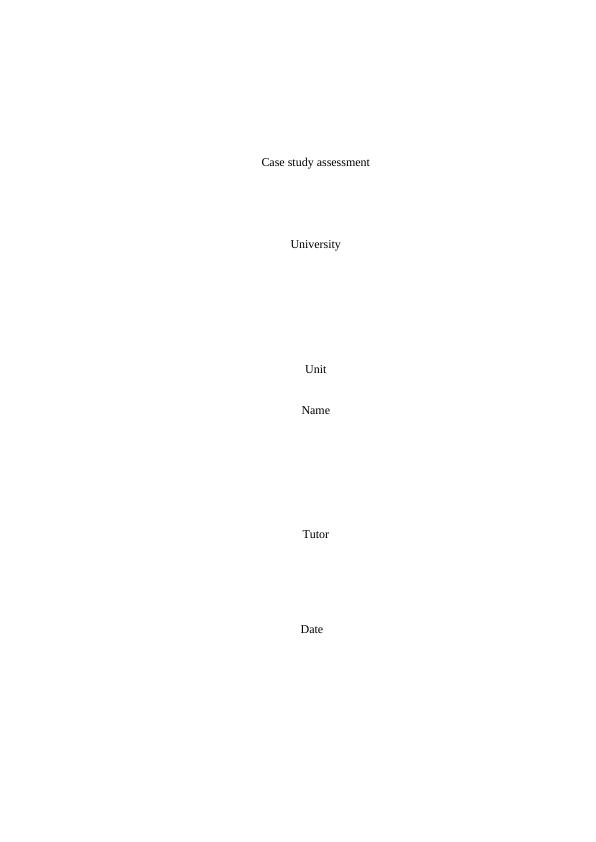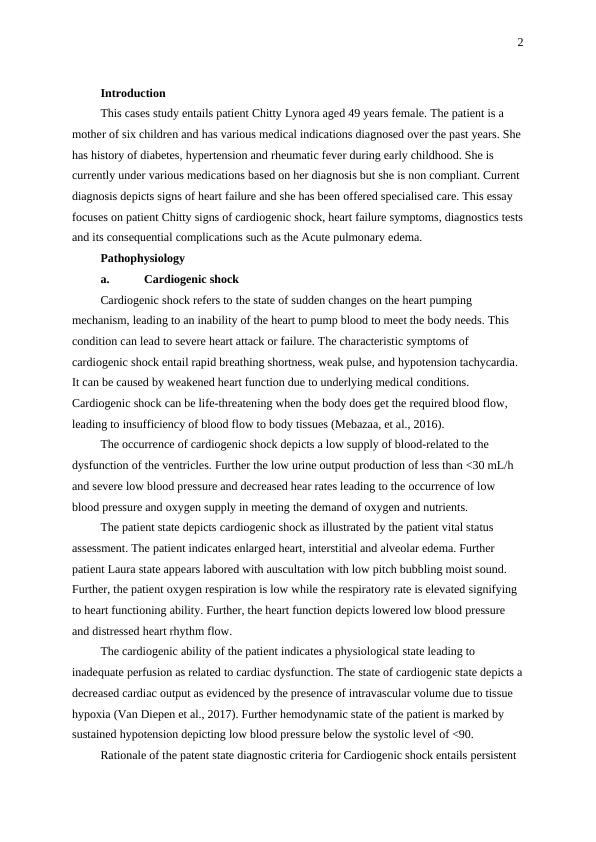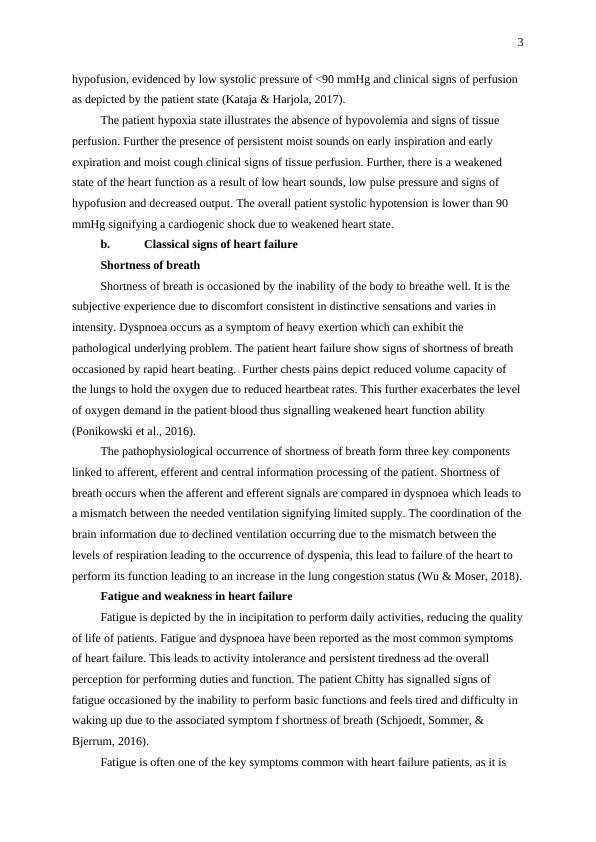Cardiogenic Shock and Heart Failure: A Case Study Assessment
Added on 2023-01-11
10 Pages3377 Words26 Views
Case study assessment
University
Unit
Name
Tutor
Date
University
Unit
Name
Tutor
Date

2
Introduction
This cases study entails patient Chitty Lynora aged 49 years female. The patient is a
mother of six children and has various medical indications diagnosed over the past years. She
has history of diabetes, hypertension and rheumatic fever during early childhood. She is
currently under various medications based on her diagnosis but she is non compliant. Current
diagnosis depicts signs of heart failure and she has been offered specialised care. This essay
focuses on patient Chitty signs of cardiogenic shock, heart failure symptoms, diagnostics tests
and its consequential complications such as the Acute pulmonary edema.
Pathophysiology
a. Cardiogenic shock
Cardiogenic shock refers to the state of sudden changes on the heart pumping
mechanism, leading to an inability of the heart to pump blood to meet the body needs. This
condition can lead to severe heart attack or failure. The characteristic symptoms of
cardiogenic shock entail rapid breathing shortness, weak pulse, and hypotension tachycardia.
It can be caused by weakened heart function due to underlying medical conditions.
Cardiogenic shock can be life-threatening when the body does get the required blood flow,
leading to insufficiency of blood flow to body tissues (Mebazaa, et al., 2016).
The occurrence of cardiogenic shock depicts a low supply of blood-related to the
dysfunction of the ventricles. Further the low urine output production of less than <30 mL/h
and severe low blood pressure and decreased hear rates leading to the occurrence of low
blood pressure and oxygen supply in meeting the demand of oxygen and nutrients.
The patient state depicts cardiogenic shock as illustrated by the patient vital status
assessment. The patient indicates enlarged heart, interstitial and alveolar edema. Further
patient Laura state appears labored with auscultation with low pitch bubbling moist sound.
Further, the patient oxygen respiration is low while the respiratory rate is elevated signifying
to heart functioning ability. Further, the heart function depicts lowered low blood pressure
and distressed heart rhythm flow.
The cardiogenic ability of the patient indicates a physiological state leading to
inadequate perfusion as related to cardiac dysfunction. The state of cardiogenic state depicts a
decreased cardiac output as evidenced by the presence of intravascular volume due to tissue
hypoxia (Van Diepen et al., 2017). Further hemodynamic state of the patient is marked by
sustained hypotension depicting low blood pressure below the systolic level of <90.
Rationale of the patent state diagnostic criteria for Cardiogenic shock entails persistent
Introduction
This cases study entails patient Chitty Lynora aged 49 years female. The patient is a
mother of six children and has various medical indications diagnosed over the past years. She
has history of diabetes, hypertension and rheumatic fever during early childhood. She is
currently under various medications based on her diagnosis but she is non compliant. Current
diagnosis depicts signs of heart failure and she has been offered specialised care. This essay
focuses on patient Chitty signs of cardiogenic shock, heart failure symptoms, diagnostics tests
and its consequential complications such as the Acute pulmonary edema.
Pathophysiology
a. Cardiogenic shock
Cardiogenic shock refers to the state of sudden changes on the heart pumping
mechanism, leading to an inability of the heart to pump blood to meet the body needs. This
condition can lead to severe heart attack or failure. The characteristic symptoms of
cardiogenic shock entail rapid breathing shortness, weak pulse, and hypotension tachycardia.
It can be caused by weakened heart function due to underlying medical conditions.
Cardiogenic shock can be life-threatening when the body does get the required blood flow,
leading to insufficiency of blood flow to body tissues (Mebazaa, et al., 2016).
The occurrence of cardiogenic shock depicts a low supply of blood-related to the
dysfunction of the ventricles. Further the low urine output production of less than <30 mL/h
and severe low blood pressure and decreased hear rates leading to the occurrence of low
blood pressure and oxygen supply in meeting the demand of oxygen and nutrients.
The patient state depicts cardiogenic shock as illustrated by the patient vital status
assessment. The patient indicates enlarged heart, interstitial and alveolar edema. Further
patient Laura state appears labored with auscultation with low pitch bubbling moist sound.
Further, the patient oxygen respiration is low while the respiratory rate is elevated signifying
to heart functioning ability. Further, the heart function depicts lowered low blood pressure
and distressed heart rhythm flow.
The cardiogenic ability of the patient indicates a physiological state leading to
inadequate perfusion as related to cardiac dysfunction. The state of cardiogenic state depicts a
decreased cardiac output as evidenced by the presence of intravascular volume due to tissue
hypoxia (Van Diepen et al., 2017). Further hemodynamic state of the patient is marked by
sustained hypotension depicting low blood pressure below the systolic level of <90.
Rationale of the patent state diagnostic criteria for Cardiogenic shock entails persistent

3
hypofusion, evidenced by low systolic pressure of <90 mmHg and clinical signs of perfusion
as depicted by the patient state (Kataja & Harjola, 2017).
The patient hypoxia state illustrates the absence of hypovolemia and signs of tissue
perfusion. Further the presence of persistent moist sounds on early inspiration and early
expiration and moist cough clinical signs of tissue perfusion. Further, there is a weakened
state of the heart function as a result of low heart sounds, low pulse pressure and signs of
hypofusion and decreased output. The overall patient systolic hypotension is lower than 90
mmHg signifying a cardiogenic shock due to weakened heart state.
b. Classical signs of heart failure
Shortness of breath
Shortness of breath is occasioned by the inability of the body to breathe well. It is the
subjective experience due to discomfort consistent in distinctive sensations and varies in
intensity. Dyspnoea occurs as a symptom of heavy exertion which can exhibit the
pathological underlying problem. The patient heart failure show signs of shortness of breath
occasioned by rapid heart beating. Further chests pains depict reduced volume capacity of
the lungs to hold the oxygen due to reduced heartbeat rates. This further exacerbates the level
of oxygen demand in the patient blood thus signalling weakened heart function ability
(Ponikowski et al., 2016).
The pathophysiological occurrence of shortness of breath form three key components
linked to afferent, efferent and central information processing of the patient. Shortness of
breath occurs when the afferent and efferent signals are compared in dyspnoea which leads to
a mismatch between the needed ventilation signifying limited supply. The coordination of the
brain information due to declined ventilation occurring due to the mismatch between the
levels of respiration leading to the occurrence of dyspenia, this lead to failure of the heart to
perform its function leading to an increase in the lung congestion status (Wu & Moser, 2018).
Fatigue and weakness in heart failure
Fatigue is depicted by the in incipitation to perform daily activities, reducing the quality
of life of patients. Fatigue and dyspnoea have been reported as the most common symptoms
of heart failure. This leads to activity intolerance and persistent tiredness ad the overall
perception for performing duties and function. The patient Chitty has signalled signs of
fatigue occasioned by the inability to perform basic functions and feels tired and difficulty in
waking up due to the associated symptom f shortness of breath (Schjoedt, Sommer, &
Bjerrum, 2016).
Fatigue is often one of the key symptoms common with heart failure patients, as it is
hypofusion, evidenced by low systolic pressure of <90 mmHg and clinical signs of perfusion
as depicted by the patient state (Kataja & Harjola, 2017).
The patient hypoxia state illustrates the absence of hypovolemia and signs of tissue
perfusion. Further the presence of persistent moist sounds on early inspiration and early
expiration and moist cough clinical signs of tissue perfusion. Further, there is a weakened
state of the heart function as a result of low heart sounds, low pulse pressure and signs of
hypofusion and decreased output. The overall patient systolic hypotension is lower than 90
mmHg signifying a cardiogenic shock due to weakened heart state.
b. Classical signs of heart failure
Shortness of breath
Shortness of breath is occasioned by the inability of the body to breathe well. It is the
subjective experience due to discomfort consistent in distinctive sensations and varies in
intensity. Dyspnoea occurs as a symptom of heavy exertion which can exhibit the
pathological underlying problem. The patient heart failure show signs of shortness of breath
occasioned by rapid heart beating. Further chests pains depict reduced volume capacity of
the lungs to hold the oxygen due to reduced heartbeat rates. This further exacerbates the level
of oxygen demand in the patient blood thus signalling weakened heart function ability
(Ponikowski et al., 2016).
The pathophysiological occurrence of shortness of breath form three key components
linked to afferent, efferent and central information processing of the patient. Shortness of
breath occurs when the afferent and efferent signals are compared in dyspnoea which leads to
a mismatch between the needed ventilation signifying limited supply. The coordination of the
brain information due to declined ventilation occurring due to the mismatch between the
levels of respiration leading to the occurrence of dyspenia, this lead to failure of the heart to
perform its function leading to an increase in the lung congestion status (Wu & Moser, 2018).
Fatigue and weakness in heart failure
Fatigue is depicted by the in incipitation to perform daily activities, reducing the quality
of life of patients. Fatigue and dyspnoea have been reported as the most common symptoms
of heart failure. This leads to activity intolerance and persistent tiredness ad the overall
perception for performing duties and function. The patient Chitty has signalled signs of
fatigue occasioned by the inability to perform basic functions and feels tired and difficulty in
waking up due to the associated symptom f shortness of breath (Schjoedt, Sommer, &
Bjerrum, 2016).
Fatigue is often one of the key symptoms common with heart failure patients, as it is

End of preview
Want to access all the pages? Upload your documents or become a member.
Related Documents
Pediatric Septic Shock Introductionlg...
|11
|3111
|267
BACHELOR NURSING ASSIGNMENT.lg...
|10
|2367
|294
Recognition and Management of Clinical Deterioration in Hospitalized Patientslg...
|10
|2655
|423
Management Strategies for Multiple Trauma: A Case Studylg...
|14
|4408
|381
Nursing Priorities and Interventions for Sepsis: A Case Studylg...
|7
|2060
|423
Pathophysiology and Nursing Goals for Post-Operative Hypovolemia in Acute Carelg...
|13
|3245
|101
